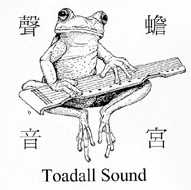|
T of C
Home |
My Work |
Hand- books |
Qin as Object |
Qin in Art |
Poetry / Song |
Hear, Watch |
Play Qin |
Analysis | History |
Ideo- logy |
Miscel- lanea |
More Info |
Personal | email me search me |
| Publications | 首頁 |
|
Toadall Sound: What's in a name?
"Chan'gong Shengyin" |
蟾宮聲音
Logo |

As a child (before I had ever driven a car) I somehow became mixed up in a few twisted minds with Mr. Toad (of Toad Hall) in the English children's story Wind in the Willows. Some years ago my former next door neighbor nature illustrator Karen Phillipps, then working on A Colour Guide to Hong Kong Animals (with Dennis Hill), was inspired by this to draw for me the illustration at right of a tree frog playing a qin. She has graciously allowed me to use this as my logo.
The Chinese for "Toadall" (Chan Gong) literally means "Toad Hall". A chan1 (rhymes with "John") was a three legged toad living on the moon; chan gong2 thus became a poetic name for the moon. More common in popular culture is the "money toad" (chan chu).3 In addition to the figures below, see also the dancing toad at the bottom of the Guanghan Qiu illustration.
And that should be the total story: even though the Latin word for "moon" is "luna", leading to the word "lunatic", "lunatic sound" should not be considered an acceptable translation for "chan'gong shengyin". Usually.
A 9-inch "jade stone" toad
4

Liu Hai tempts a toad

Footnotes (Shorthand references are explained on a
separate page)
1.
Chan 蟾
8/979; 34511.0 蟾蜍蟲也 same as chanchu (see below), sometimes used to refer to a common toad (bufo vulgaris), but more commonly to a three-legged good luck toad. The chan was considered particularly lucky as a symbol for longevity (toads can live for 30 years or more) as well as for money-making (as represented by the illustration at right, showing 劉海 Liu Hai with his foot on such a toad while enticing it with a string of gold coins). There is no indication of how this toad came to have three legs.
(Return)
2.
Chan Gong 蟾宮
34511.11 has as references 袁郊,月詩 Moon Poem by Yuan Jiao (9th c.; Bio/1830) and 李俊民,中秋詩 Mid-Autumn Moon Poem by Li Junmin (13th c.). 34511.0/b say 蟾 chan by itself can also refer to the moon; the reference is 廣韻 Guang Yun (Expanded Rhymes, first published 1008).
(Return)
3.
Chan Chu 蟾蜍
34511.23 sites references from the 後漢書 Annals of the Latter Han Dynasty to the story of Hou Yi and Chang E, related here with the melody Guanghan Qiu.
In addition, there is quite a bit of online information about the "wealth toad" in popular culture. See, for example, a UCI web page.
(Return)
4.
This stone toad was described to me as "a jade stone object dug up in northeast China, perhaps Liao dynasty (907-1125)". Another opinion is that based on its style it could date from any time in the past 2,000 years -- similar carved animals are commonly found in tombs beginning from the Han dynasty, and even then they were probably rough replicas of what in earlier tombs had been more elaborate figurines.
(Return)
Return to my publications
or to the Guqin ToC